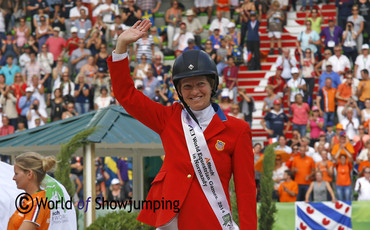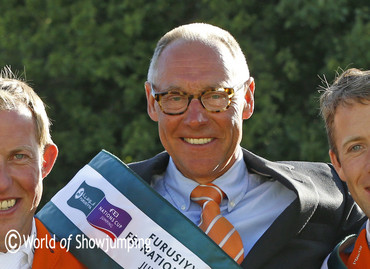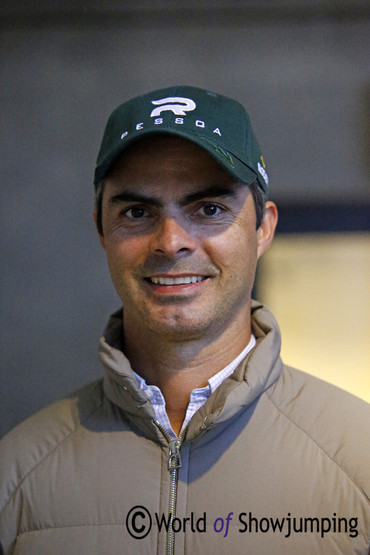Ever since a ring crew member jumped back over that hedge of flowers in the huge grass ring in Aachen during this summer’s European Championships, the Olympic showjumping qualification system has been under discussion. The reason; Cian O’Connor’s Good Luck lowered the front rail on the following oxer. Had the pole stayed in the cups (or perhaps the ring crew member on the right side of the hedge of flowers), Ireland would have qualified for the 2016 Olympics instead of Spain. This "sudden death” approach - as it was labeled by Pippa Cuckson in the article "Who Needs the Luck of the Irish...." - has been criticised for being less than ideal when it comes to deciding which nations should be able to compete at the Games. [1]
Rodrigo Pessoa, member of the FEI Jumping Committee, confirms to World of Showjumping that reviewing the qualification rules for the Olympics is one of the tasks the committee currently is busy with. “We are looking into whether or not there could be flaws in the system, and if yes trying to find solutions to the problem," Pessoa says.
While some find the current qualification system satisfactory (and would say that Olympic qualification could have been secured for Ireland with one of the other of their team members going clear), others have supported alternative qualification ideas - criticising the lack of reward when it comes to consistency in today’s rules. One approach to exclude the sudden-death-outcomes has involved playing with the possibility of letting the Nations Cup series replace the championships and special qualifiers as qualifying events.
The question is; would that make a system that is more fair than the one that exists today?
 "The current system is not bad, but it can be improved,” Beezie Madden says. Photo (c) Jenny Abrahamsson.
"The current system is not bad, but it can be improved,” Beezie Madden says. Photo (c) Jenny Abrahamsson.
Under the rules, qualification takes place at the World Equestrian Games, the European Championships, the Pan Am Games as well as through special qualifiers. [2] Unless already qualified through the WEG, the lengthy European Championships for teams decide for countries from Group A and B, and the best two teams from the competitions at the Pan Am Games also get a ticket for the Olympics. For Group C, F and G on the other hand, there are special qualifiers - which usually just involve one competition over two rounds in a single day - like any other Nations Cup.
"The current system is not bad, but it can be improved,” says Beezie Madden - one of the world's leading riders for decades - to World of Showjumping when discussing the topic. "I think in the future the FEI will need to have a qualification system for the World Equestrian Games, since there were too many teams in Normandy last year. For sure, the Nations Cup Leagues could be used to qualify teams for the WEG. Then for the Olympic Games qualification, I think we should still qualify some teams from the WEG and the continental championships, but perhaps fewer teams than are currently qualified from them. This would help to keep the continental championships important, and also ensure that a team that has already proved itself at the top of the WEG or continental championships does not have to do more to qualify for the Olympics."
Madden continues; "It would be great to use the Nations Cup Final as a qualifier, but most of the countries in the Final will already be qualified through the WEG or continental championships. So I think it is best to use the results from the leagues to qualify for the remaining slots."
"Perhaps it would be possible to decide the last team or two to qualify by having a last chance qualifying competition. This would be a new event and all or some of the teams that missed out on qualifying through the leagues could all compete against each other. The winner, and maybe the second placed team, would go on to the Olympics. This might be close to impossible to organize and get teams from all over the world together, but I think it would be interesting," Madden reflects continuing "I would prefer a concept like this more than the special qualifiers currently taking place."
Dutch Chef d’Equipe Rob Ehrens, who recently was appointed to the FEI Jumping Committee, agrees that the qualification system can be improved. His biggest concern is the special qualifiers. “I think the current qualification system could be better,” he says. "That we all have to qualify is normal, but I believe that there are too many occasions that it happens behind closed doors and then the competition is no level playing field in my opinion. I prefer to use events such as the World Equestrian Games and the European Championships as qualifiers, they should give enough opportunity to qualify.”
 Rob Ehrens on getting to the Olympic Games; “All the qualifications need to be the same." Photo (c) Jenny Abrahamsson.
Rob Ehrens on getting to the Olympic Games; “All the qualifications need to be the same." Photo (c) Jenny Abrahamsson.
As pointed out in the ongoing discussions, it can seem completely unfair that a nation like Belgium will not be travelling to compete at the Olympic Games next year. Belgium won the Furusiyya FEI Nations Cup Final in Barcelona this year, the Europe Division 1 league overall and had three of it’s four riders in the individual final at the Europeans in Aachen. Still their Rio-dream was brought to an abrupt end when they missed out on the team final at the Europeans, and the chance to qualify, by a sad 0.2 penalties.
“Belgium’s season does certainly not reflect in the fact that they did not qualify for the Olympics,” says Pessoa. “But there are sport moments where that specific day counts - such as with the current qualification system, and unfortunately they did not deliver good enough there and then.”
So, perhaps would the Furusiyya FEI Nations Cup series serve as a better instrument when it comes to measuring consistent performances compared to the current Olympic qualifying events?
Looking at the rules for the Nations Cup series it can seem like a good idea. But, studying how the series unfold outside the paper will make you think twice.
Lets start with the series’ Europe Division 2 League. [3] This league has a much larger number of teams than any of the others; this year it had 13, which is five more than in the Europe Division 1 League - the second largest of the series.
Reading the rules, the Division 2 League may seem very similar to Division 1 - but looking at how it is actually working it will tell a different story. This is mainly due to the point distribution and team allocation system that has been chosen for the Nations Cup series. [4]
At the 2015 leg in Lisbon, Finland collected the second best score of 90 points as they were the only team in addition to Portugal allocated to pick up points out of the nine countries competing. The 90 points were given even though the results show that Finland finished eight - second last - with only one team member completing round two. Portugal, that finished second at the same leg of the series, only got ten points more - the maximum 100 as the best of the two at the event. Yet there was a sea of penalties separating the two countires in the actual competition.
And looking back to the stage in Gijon in August, Ukraine was the only team allocated from Europe Division 2 and got 100 points no matter how they finished.
 Rodrigo Pessoa confirms that the FEI Jumping Committee is looking into whether or not there could be flaws in the system. Photo (c) Jenny Abrahamsson.
Rodrigo Pessoa confirms that the FEI Jumping Committee is looking into whether or not there could be flaws in the system. Photo (c) Jenny Abrahamsson.
Another example of how results and point distribution do not go hand in hand is the North American, Central America and Caribbean League. [5] This year it was supposed to have three qualifying events, but only ended up having two - with USA and Mexico taking the two spots for the final. The third nation that competed in the series - Canada - missed out. At the end of the series, Canada and Mexico had the same amount of points though - 170.
At the first qualifier at Ocala, USA ended second and got the maximum of 100 points, Canada was third earning 90 points and Mexico sixth - still earning 80 points due to the point distribution system.
At the second qualifier hosted by Coapexpan - USA won, Mexico was second and Canada third.
Due to the point distribution, Mexico and Canada at the end of the series earned the same amount of points - even though Canada twice finished third compared to Mexico’s 6th and 2nd. According to the rules, the latter 2nd place gave Mexico the advantage when it came to a ticket for the final. But, where is the consistency - on team Canada or team Mexico? Some simple math will give the answer.
“To use the Nations Cup series to qualify for the Olympic Games I think that the format of the series needs to be improved. I don’t like the point system all that much. I think it would be better if the points that are handed out reflect a team’s actual results, and with the current distribution system it does not. A point distribution system that would reflect the actual result of the competition would also be easier to follow, and it would open for more strategising - encouraging the countries to send strong teams to all Nations Cup events, for example also where they would not earn points but then to ‘block’ other teams from a top result to improve their own rank on the overall standings,” Madden says.
Rob Ehrens is not positive to using the Nations Cup series as a way to qualify for the Games. "The Nations Cup events have to be seen separate, and not end up as a way to qualify for the Games,” Ehrens says to World of Showjumping. "Then there would be no level playing field, because not all the Nations Cups are even within the same level.”
Ehrens is clear on what he believes is the most important aspect when it comes to the qualifying events for the Olympics; “All the qualifications need to be the same. And with the current system, there must be a clear view over all the shows that count as qualifiers so that we don’t hear afterwards that there was an event behind closed doors. As to the sport itself I belive it can be improved. The combinations competing must have the capacity and ability, and should have a solid long-term partnership. The horse-and-rider-combinations should in my opinion compete for their country together for over a longer period of time ahead of the Games.”
Working so differently from league to league, and so accidental with the team allocation and chosen point distribution - it’s hard to see how the Nations Cup series in it’s current cast could serve any better for the purposes of qualifying for the Olympics than the current events drawn up in the rules. To be able to use the series for this cause, it certainly has to be improved.
Either way it’s hard to disagree with Beezie Madden’s prediction; "No matter what you do, there is always somebody that should have qualified that does not."
Text and photos copyright © worldofshowjumping.com 2015.
External links:
[1] Who Needs the Luck of the Irish.... Article by Pippa Cuckson on horse-canada.com 26th of August 2015; http://www.horse-canada.com/cuckson-report/who-needs-the-luck-of-the-irish/
[2] Qualification system - Rio Olympics 2016; http://fei.org/system/files/Jumping%20Rio%202016%20-%20Qualification%20System_26%20August2015_0.pdf
[3] Furusiyya FEI Nations Cup Standings and Results Europe Division 2 2015; http://www.fei.org/system/files/D2_2015%2009%2014_0.pdf
[4] Point distribution system Furusiyya FEI Nations Cup; http://www.fei.org/fei/events/fei-nations-cup-series/furusiyya/points-rules
[5] Furusiyya FEI Nations Cup Standings and Results North America, Central America & Caribbean League 2015; http://www.fei.org/system/files/NA_CA_CAR_2015%2005%2007_0.pdf









